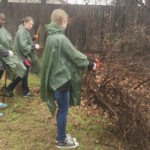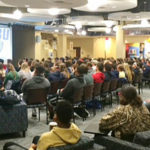I started my sermon by calling about five people out of the congregation to the front of the church. I asked them to join hands and form a circle. I knew exactly what that circle was going to look like. They turned inward, facing each other and circled around. Some were facing the congregation, some had their backs to the people, others were profiled left or right. Wherever they stood, though, they primarily were looking at each other.
 Jeff JohnsonI asked, “Is this the only kind of circle you can make?” After a few perplexed moments, the circle-formers decided “getting closer” was the only way they could form a “different” circle.
Jeff JohnsonI asked, “Is this the only kind of circle you can make?” After a few perplexed moments, the circle-formers decided “getting closer” was the only way they could form a “different” circle.
First they moved closer together, though still just holding hands. Then every time I urged them to make yet another “different” circle, this group responded by moving closer and closer. They stood shoulder-to-shoulder; they dropped hands and put their arms around each other; they finally squashed themselves into a kind of football-type huddle.
(Note to self : A group curved in on itself, in the process of imploding).
Finally, as I urged them one last time to make still another circle, someone from the audience helped these poor crushed circlers out: “Why don’t you turn around? Face out, instead of facing in.”
With that bit of help, a whole new circle became possible. Now—getting it—they formed yet another kind of circle. This time, they stood sideways to the center of the circle. Here their vision looked both ways. They could see the person in front of them, but they could also see other members of the circle across from them, as well as having a clear view of people outside the circle. They made a “looking out” rather than a “looking in” circle.
We’re taught to face in
Why was that such a strange, radical idea for us? I suppose from the time we are little children, we are taught circles face in. Our inability to conceive of a different kind of circle helped us commiserate with Jesus disciples’ denseness when they were caught up in making the same old circle.
Sometimes, I think the church stands around holding hands, just looking at each other and changing the size of our inward-looking circle. We have become much too fixated on how to save ourselves rather than saving the world.
Sign up for our weekly edition and get all our headlines in your inbox on Thursdays
Some Texas Baptists are making a different kind of circle. A large group of college students are thinking about how they represent Jesus and serve others differently. They are our Go Now Missionaries.
Go Now Missions
Go Now Missions offers many ways for college students to serve throughout the year. They become part of something bigger by serving as Christmas break missionaries, 10-week summer missionaries, two- to four-week Summer Impact Team missionaries, or four- to 10-month semester missionaries.
Would you as a Texas Baptist commit to pray for these college students this summer? You can find out more from Bruce McGowen, Joyce Ashcraft, Brenda Sanders or a local Baptist student minister. They can send you a great poster of all the student missionaries to guide you as you pray. All you have to do is ask, and they will send it to you.
Final question: How do you make a circle?
Jeff Johnson is president of the Baptist General Convention of Texas and pastor of First Baptist Church in Commerce.














We seek to connect God’s story and God’s people around the world. To learn more about God’s story, click here.
Send comments and feedback to Eric Black, our editor. For comments to be published, please specify “letter to the editor.” Maximum length for publication is 300 words.